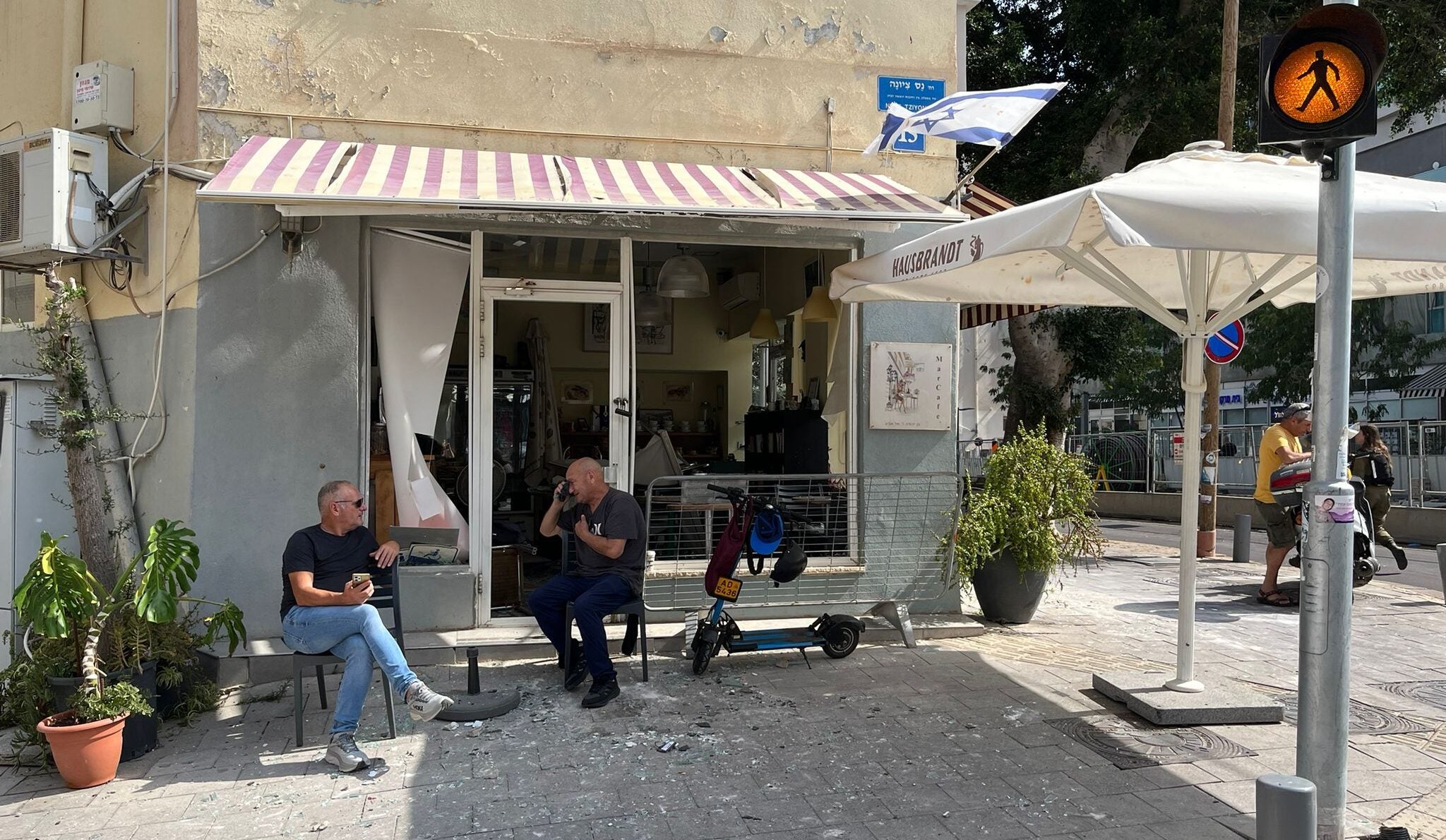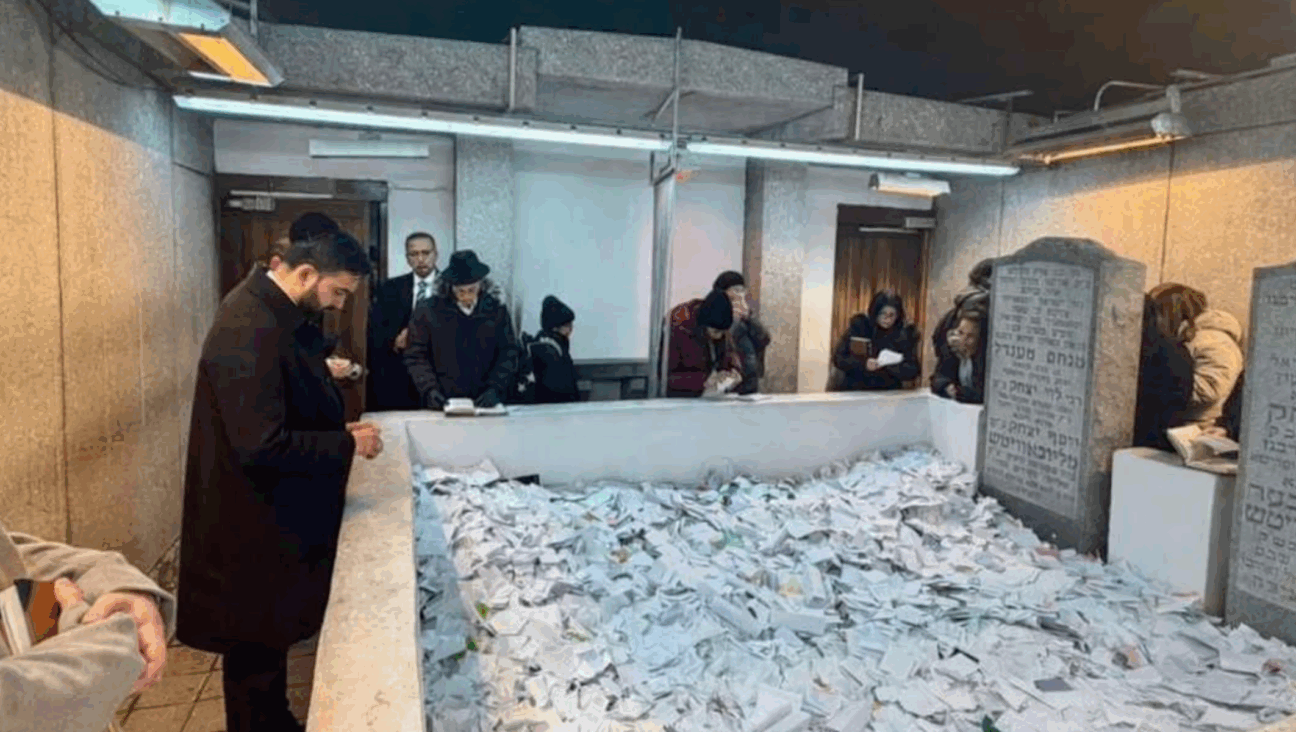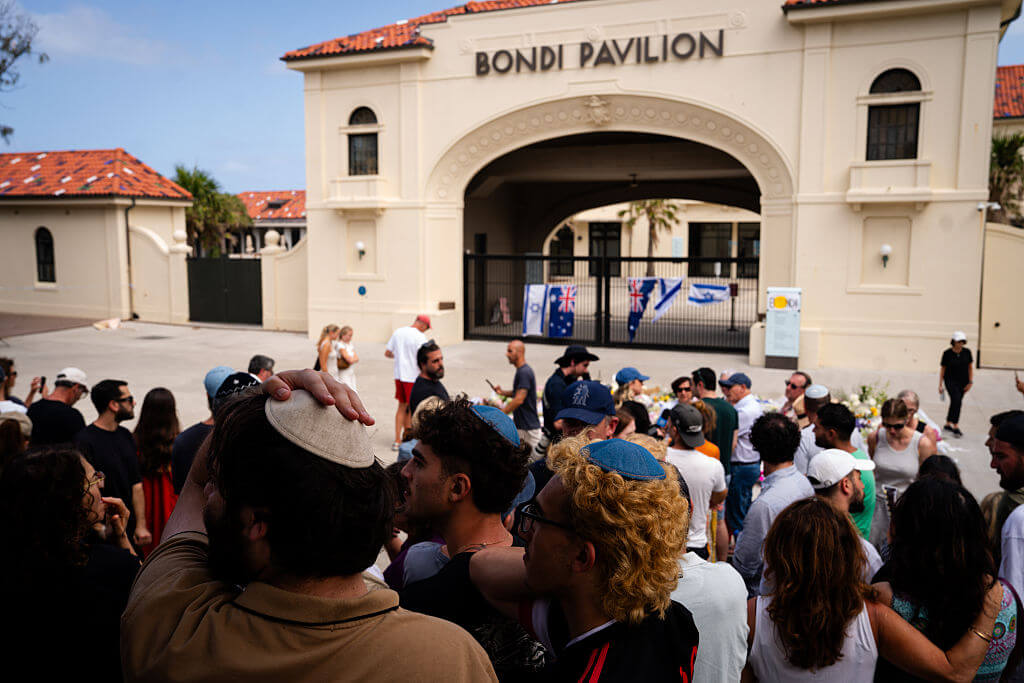For Israelis under Iranian barrage, deadly nights alternate with days brimming with life
For this former Londoner, the booms from Iranian missiles are reminiscent of the Blitz

Patrons of a cafe whose windows were shattered by a nearby missile impact sit next to piles of broken glass, Tel Aviv, June 16, 2025. (Niv Elis)
(JTA) — TEL AVIV — The booms from the night’s Iranian missile strike could be felt across the region, including in my home in Jaffa. In that moment, it felt — to this former Londoner’s ears — like a scene from the Blitz, when the Nazis pounded England with nightly bombs.
Then, Brits poured into Tube stations to wait out each night’s barrage together, before emerging and carrying on with their lives — in a pattern that Israelis have sought to replicate during the harrowing first days of war with Iran.
After four days of Iranian missile strikes that have killed 25 people, wounded hundreds, and left thousands without homes, Israel has settled into a new kind of duality: fear of what lies ahead, and an effort to maintain some semblance of ordinary life. By Monday afternoon, despite the devastation, beaches were full, shops even more so, and many people returned to work, balancing between anxiety and routine.
On Sunday night, Gabriella Turner, a Jerusalem resident, had come to help her sister in central Tel Aviv care for her 2-year-old nephew after her sister fell ill with food poisoning. When the incoming sirens began, they moved into the safe room.
“Out of nowhere this massive boom, the whole place shook like the floor moved underneath us,” Turner said. “We kind of flew on to each other and for a second I really thought the building had been hit. I just froze, thinking: What if I can’t get out?”
She recalled: “My nephew … was so terrified. We tried to explain to him that everything was going to be okay, and it was just a boom, but we weren’t even sure that it was going to be OK.”
When they eventually looked outside, they saw that the hotel next to them had taken a direct hit — shielding their own building. Its facade destroyed, cars were ablaze and shopfronts lay in ruins.
“The scariest part is knowing that these missiles aren’t targeting soldiers or military sites, they’re targeting homes, families, a baby sleeping in his crib,” Turner said. “That’s what stays with you, that someone wanted this to happen, and that’s crazy in my eyes.”
Elsewhere in northern Tel Aviv, a missile slammed into an apartment building near the home of Kate Leaman, a market analyst originally from the United Kingdom. The blast shook her own high-rise tower. “It felt like the bomb was on my building,” she said.
Leaman said that since the first night of the Iranian strikes, she and her ex-husband had decided to split up their two children because, she said, “when they’re together it’s just chaos.”
“It’s a temporary arrangement just to get through this. Because even we adults are overstimulated, it’s just too much.”
Her daughter’s teacher was unable to hold a planned Zoom class on Monday morning after her own home was destroyed. Leaman was scheduled to join a work call, but could barely concentrate.
“I usually write the financial news and I’ve never missed a day, not during Hamas [rockets], not during Covid. But I did today,” she said. “But my Israeli colleagues were acting like everything’s normal. Israelis are cut from a different cloth from us, aren’t they?”
By the afternoon, beaches along the Tel Aviv coast were packed with volleyball and football games, but most of the players were young people, with few children or families in sight.
A day earlier in nearby Bat Yam, where a missile had slammed into a residential building the previous night, killing nine people including three children, the high street was open and busy. Shops with shattered windows from the shockwaves continued to serve customers. A shoe store owner shrugged: “Why should I stay at home? What will I do there?”
At the Bat Yam strike site, where Prime Minister Benjamin Netanyahu had just toured, police maintained a cordon while soldiers were handed energy drinks. A Chabad outreach truck known as a “mitzvah tank” played music nearby, while another van belonging to the Na Nach Nachman subsect of the Breslover Hasidic movement – a group known for dancing atop their vehicles – stood idle and silent. Its driver, who arrived in Bat Yam from his home in the Golan Heights, said he had hoped to lift spirits with music but changed his mind after arriving.
“It didn’t feel quite right,” he said. “But when it is, I’ll fire the music up. Everyone has their part to play. One brings food, another first aid, another joy.”
The scenes of destruction also reignited debates over Israel’s shelter infrastructure on Monday. State Comptroller Matanyahu Englman, visiting the Bat Yam site, noted that roughly a quarter of Israel’s population lacks access to proper bomb shelters. In local WhatsApp groups, Israelis argued over whether public bomb shelters or private safe rooms offered better protection. One poster insisted underground shelters were safer, while another pointed out that many public shelters are decades old, poorly maintained and not designed for modern threats. Others emphasized that while private safe rooms are built to absorb shockwaves and shrapnel, they have never been tested against the kind of heavy ballistic missiles fired by Iran.
“Better to be in a mamad than risk being buried under rubble,” one person wrote, referring to the newer in-home safe rooms.
The debates extended to the practicalities of sheltering: Some reported that their public shelters were stifling hot after vandals stole air-conditioning units while others complained that neighbors refused to shut the heavy door, despite repeated warnings that included, in one case, a visual aid using a plastic bottle to demonstrate the relative ease of crushing it with and without its cap.
Yana, who lives near the site of the Bat Yam strike, said she usually stayed in the stairwell during Hamas and Houthi attacks rather than going outside to public shelters.
“I feel bad leaving my cats alone. But this time I felt I had to go. These aren’t launches from Gaza,” she said.
Nearby, Rom, a teenager with a large tattoo on his shin, said he had come “to check out the pretty cops.” Like Yana, he had no shelter in his home. “But I’m not moving. I sit on my couch and wait for those Iranian bastards,” he said. “If it’s my time, it’s my time. God will protect me.”
Around 4 p.m., as early warning signals began to sound again, people quickened their pace but showed little panic. This reporter searched for shelter, checking a health clinic and a bank without success. When the sirens blared, the mood shifted, and people scrambled through the streets. An Orthodox man standing on the sidewalk pointed to stairs leading down to a synagogue.
No one else was there at first. I sat down next to the Ark, vaguely recalling the many social media posts of Torah scrolls that had miraculously survived past attacks intact and figuring it could be my best chance of survival. But then the Orthodox man returned and gestured for me to move, pointing to the ceiling panels above blown out by shockwaves from the previous night’s strike. I moved to sit next to a woman in a tank top reading from a book of Psalms. “There’s no service in here, what else are we going to do?” she said.
Another woman, Jenny, originally from Congo and living in Israel for 16 years, apparently did have service, and was showing others her Red Alert app, filled with red pins indicating where sirens had been activated.
She had been on her way to visit relatives hospitalized from the Bat Yam strike — her sister, brother-in-law, and brother — when the sirens sounded again. Her 8-month-old nephew, physically unscathed, had become unresponsive overnight. “Yesterday he was laughing, smiling, eating. Today he’s doing none of those things,” Jenny said.
“I have high blood pressure which was starting to relax after nearly two years of Hamas but now it’s skyrocketing,” she said. “I know God is always working extra hard in this country, but still, I’m very, very scared.”














